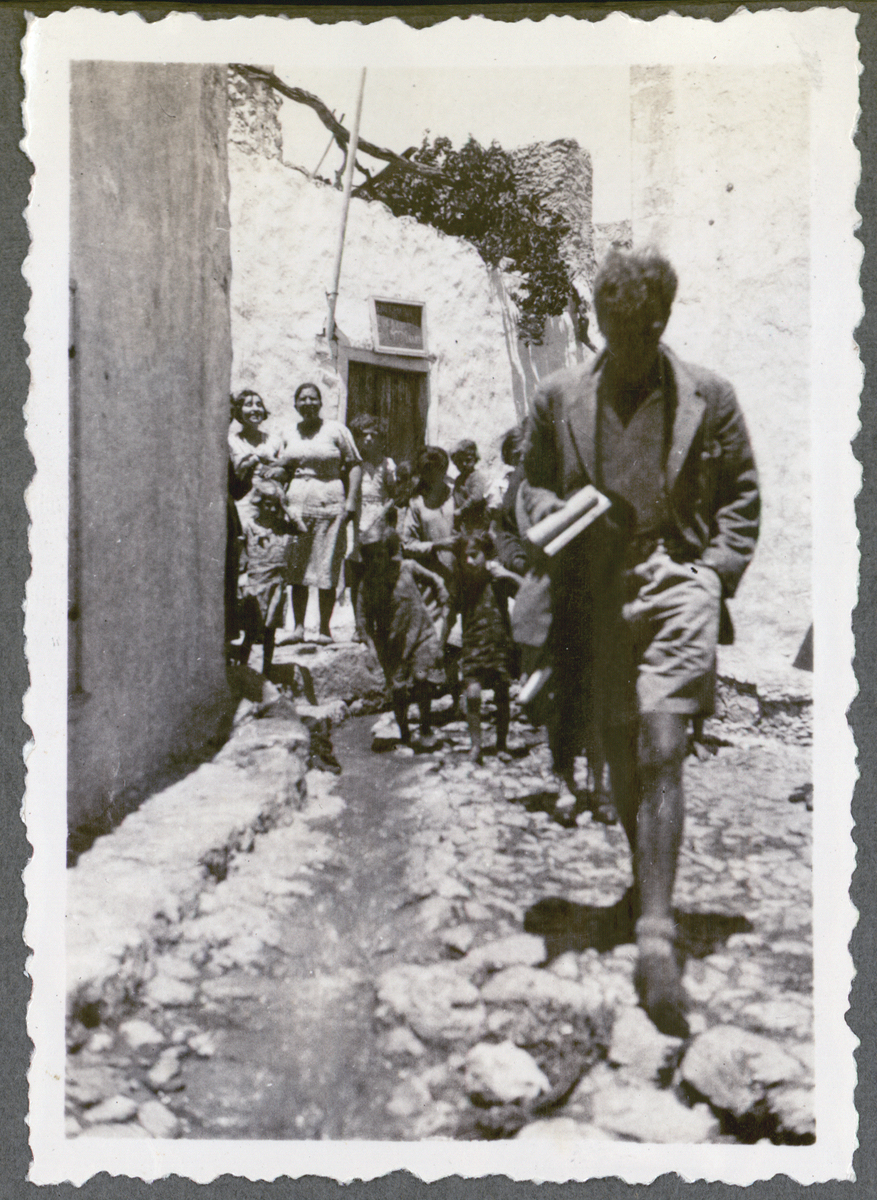About the John Pendlebury Family Papers

The John Pendlebury Family Papers cover the period from 1913 to 1964 and document the life of archaeologist and WWII hero John Devitt Stringfellow Pendlebury, his wife Hilda and their family.
[View from mainland Crete, looking north].
[Photograph taken from a boat, by Hilda White].
[Photograph taken by Hilda White].
Traced by [John Pendlebury] from ‘Excavations on the Island of Pseira, Crete’ by Richard Seager.
View across roof tops, to landscape beyond.
With anchored and moored boats in the foreground.
Taken from a ship during the journey from Athens to London.
Taken from a ship during the journey from Athens to London.
Photograph includes legs of people standing on the wall.
The page in the travel log this photograph is pasted onto is labelled, in the upper right corner, 'Melrose Abbey, Edinburgh', but the photo is of the inside of Rosslyn Chapel, Roslin, Scotland
The page in the travel log this photograph is pasted onto is labelled, in the upper right corner, 'Melrose Abbey, Edinburgh', but the photo is of the exterior of Rosslyn Chapel, Roslin, Scotland
The page in the travel log this photograph is pasted onto is labelled, in the upper right corner, 'Melrose Abbey, Edinburgh', but the photo is of the inside of Rosslyn Chapel, Roslin, Scotland
The page in the travel log this photograph is pasted onto is labelled, in the upper right corner, 'Melrose Abbey, Edinburgh', but the photo is of the inside of Rosslyn Chapel, Roslin, Scotland
The page in the travel log this photograph is pasted onto is labelled, in the upper right corner, 'Melrose Abbey, Edinburgh', but the photo is of a tree near Rosslyn Chapel, Roslin, Scotland
The page in the travel log this photograph is pasted onto is labelled, in the upper right corner, 'Melrose Abbey, Edinburgh', but the photo is of the inside of Rosslyn Chapel, Roslin, Scotland
Material relating to the excavation of Trapeza Cave near Tzermiado, Lasíthi Plain, Crete (4-19 May 1936). This excavation took place under the auspices of the British School at Athens and was conducted by John Pendlebury, Hilda Pendlebury, Mercy Money-Coutts and Ralph Lavers. With Manolaki (from Knossos) and Ioannes Meliarakes as foremen. The notebook contains: a list of workmen (mainly from Tzermiado); a description of the cave including location, what locals said about the cave and sherds found on an earlier trip in June and July 1935; diagrams of stroses [stratigraphy] inside and outside the cave; a hand drawn plan of the Lasithi plain; a cross section diagram of part of the cave; a rough diagram of the cave divided into sections based on a sketch by [Ralph] Lavers; a “diagrammatic section of the cave, showing strata excavated”; and a catalogue of photographs listing negative numbers, description and how numbered objects were arranged in the photographs. The notebook also contains (written from the other end of the book): notes on the analysis of “stroses” [stratigraphical layers] including details of objects found in sections and bones thrown away; catalogues of finds divided into “stone vases and objects”, “beads, buttons etc and miscellaneous”, “metal” detailing reference numbers, material, dimensions, any remarks, the provenance (exact section of cave), whether there was a drawing and photograph number; and lists of seals and figurines divided into type and detailing reference number and material. Mostly in John Pendlebury’s handwriting, but also includes notes in Hilda Pendlebury’s handwriting and another person’s [possibly Mercy Money-Coutts or Ralph Lavers].
Material relating to the excavation of Trapeza Cave near Tzermiado, Lasíthi Plain, Crete (4-19 May 1936). This excavation took place under the auspices of the British School at Athens and was conducted by John Pendlebury, Hilda Pendlebury, Mercy Money-Coutts and Ralph Lavers. With Manolaki (from Knossos) and Ioannes Meliarakes as foremen. The notebook contains a catalogue [mainly in Hilda Pendlebury’s handwriting] of objects found at the excavation divided into bronzes and metal, stone, seals, pottery, figurines and miscellaneous. The catalogue contains object numbers, provenance (exact section of cave), description of object, a small sketch, size and photograph number. Also includes a list [in John Pendlebury’s handwriting] of objects left at [the excavation house in Tzermiado] such as utensils and crockery.
Material relating to excavations near Tzermiado, Lasíthi Plain, Crete, including Karphi. Comprises notes about test excavations, and bigger excavations at Karphi, Argoulia Cave, near Trapeza Cave, Skaphidia Cave, Kastellos, Donadhes (Lagou), Kolonna (Lagou), Kerasa, Agiou Georgiou Papoura, Sta Mnemata, Mikre Koprana, Meskine Cave, Astividhero, and Vitzelovrysis. The notes include descriptions of sites, lists of finds, and references to photographs and objects (references starting “Tz”), and are most extensive for Kastellos, Karphi and Sta Mnemata. The notebook also contains (starting from the other side of the book) rough diagrams relating to Kastellos, Skaphidia Cave, Donadhes, Kolonna, Kerasa, Papoura, Sta Mnemata, Karphi, Meskine Cave and Astividhero. The notes were written by several different people [including John and Hilda Pendlebury].
Material relating to excavations near Tzermiado, Lasíthi Plain, Crete, including Karphi. The notebook contains a catalogue [partly in Hilda Pendlebury’s handwriting] detailing objects found at excavations: object numbers, provenance (site and exact location), description of object, small sketches of items, size and photograph number. The object numbers begin “Tz”. The objects catalogued are from Karphi, near Trapeza Cave, Kastellos, Donadhes, Kolonna, Kerasa, Papoura, Sta Mnemata, Karphi, Vitzelovrysis, Mikre Koprana, Astividhero, road from Kolonna to Tzermiado, and Meskine Cave. Also contains (from other end of notebook) a list of [items at excavation house in Tzermiado] and a photographic catalogue detailing photograph number (reference numbers starting “O.”), provenance of items in photograph, description of items, material of object, date of object, and distribution of objects on the photograph.

